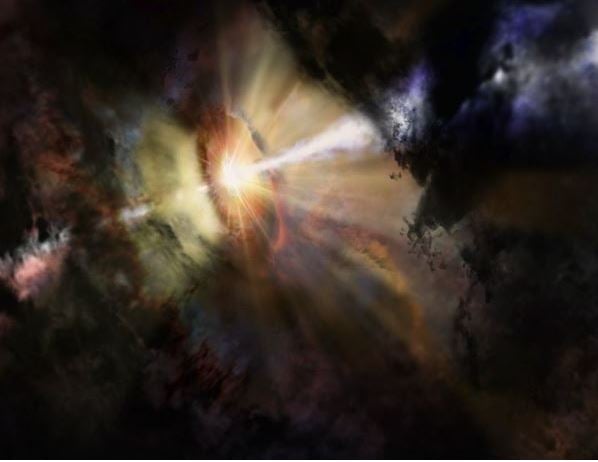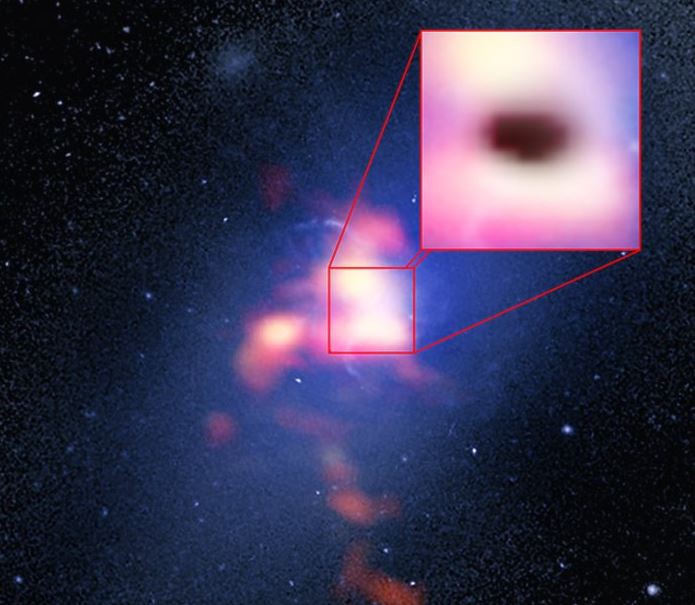Astronomers have found a supermassive black hole devouring clouds of clumpy gas racing towards it – the first clear evidence of a chaotic cold ‘rain’ feeding a supermassive black hole, says an international team of scientists.
Scientists had thought that supermassive black holes in the biggest galaxies fed on a slow, steady supply of hot, ionized gas from the galaxy’s halo, the Yale-led team of astronomers explained in the journal Nature (citation below).
 As described by the European Southern Observatory: “The cosmic weather report, as illustrated in this artist’s concept, calls for condensing clouds of cold molecular gas around the Abell 2597 Brightest Cluster Galaxy. The clouds condense out of the hot, ionised gas that suffuses the space between the galaxies in this cluster. New ALMA data show that these clouds are raining in on the galaxy, plunging toward the supermassive black hole at its centre.” (Image: eso.org. Credit: Dana Berry/SkyWorks)
As described by the European Southern Observatory: “The cosmic weather report, as illustrated in this artist’s concept, calls for condensing clouds of cold molecular gas around the Abell 2597 Brightest Cluster Galaxy. The clouds condense out of the hot, ionised gas that suffuses the space between the galaxies in this cluster. New ALMA data show that these clouds are raining in on the galaxy, plunging toward the supermassive black hole at its centre.” (Image: eso.org. Credit: Dana Berry/SkyWorks)
Supermassive black hole with mass of 300 millions Suns
Lead author, Yale astronomer Grant Tremblay, said:
“Although it has been a major theoretical prediction in recent years, this is one of the first unambiguous pieces of observational evidence for a chaotic, cold ‘rain’ feeding a supermassive black hole.”
“It’s exciting to think we might actually be observing this galaxy-spanning ‘rainstorm’ feeding a black hole whose mass is about 300 million times that of our Sun.”
This latest discovery offers scientists new insight into how black holes ingest fuel, a process known as accretion. Black holes most commonly feed by taking in hot, ionized gas that gradually spirals from a surrounding disc of cosmic material.
 Another artist’s depiction of cold intergalactic rain deep in the heart of the Abell 2597 Brightest Cluster Galaxy. (Image: eso.org. Credit: Dana Berry/SkyWorks)
Another artist’s depiction of cold intergalactic rain deep in the heart of the Abell 2597 Brightest Cluster Galaxy. (Image: eso.org. Credit: Dana Berry/SkyWorks)
1 billion light-years away
Dr. Tremblay, A NASA Einstein Fellow at Yale, and colleagues analysed data from the ALMA (Atacama Large Millimeter/submillimeter) telescope Chile to map movement and locations of cold molecular gas in the Abell 2597 Cluster – a knot of approximately 50 galaxies about one billion light years from Earth.
The astronomers detected a trio of cold gas clouds hurtling at up to one million kilometres per hour, heading towards a black hole in a galaxy located at the centre of the cluster. Each gas cloud contains enough material to create one million Suns, and measuring several tens of light-years from one end to the other.
Co-author C. Megan Urry, the Israel Munson Professor of Physics and Astronomy at Yale, said:
“We can’t know whether all or only part of this ‘meal’ of cold gas will ultimately fall into the black hole, but the ALMA data spectacularly highlights the importance of this kind of cold accretion.”
Co-author, Louise Edwards, an astronomy lecturer and researcher at Yale, said:
“Since we know so little about the mechanics of how the AGN (active galactic nucleus) interacts with the rest of the galaxy, this is a real step forward.”
 A composite image of Abell 2597 brightest cluster galaxy. The background image (in blue) is from the NASA/ESA Hubble Space Telescope, while the foreground (red) is ALMA data showing the distribution of carbon monoxide gas in and around the galaxy. (Image: eso.org. Credit: B. Saxton & G. Tremblay et al.)
A composite image of Abell 2597 brightest cluster galaxy. The background image (in blue) is from the NASA/ESA Hubble Space Telescope, while the foreground (red) is ALMA data showing the distribution of carbon monoxide gas in and around the galaxy. (Image: eso.org. Credit: B. Saxton & G. Tremblay et al.)
The authors said they now plan to use the ALMA telescope to seek out similar ‘rainstorms’ in other galaxies to determine whether such cosmic weather is a common phenomenon.
In an Abstract that describes the main paper in Nature, the scientists wrote:
“The observations show that these cold clouds also fuel black hole accretion, revealing ‘shadows’ cast by the molecular clouds as they move inward at about 300 kilometres per second towards the active supermassive black hole, which serves as a bright backlight.”
“Corroborating evidence from prior observations16 of warmer atomic gas at extremely high spatial resolution17, along with simple arguments based on geometry and probability, indicate that these clouds are within the innermost hundred parsecs of the black hole, and falling closer towards it.”
According to the European Southern Observatory:
“The shadows are formed when the in-falling opaque gas clouds block out a portion of the bright background millimetre-wavelength light emitted by electrons spiraIling around magnetic fields very near the central supermassive black hole.”
Citation: “Cold, clumpy accretion onto an active supermassive black hole,” Helen R. Russell, Alice C. Quillen, C. Megan Urry, Grant R. Tremblay, J. B. Raymond Oonk, Françoise Combes, Philippe Salomé, Christopher, P. O’Dea, Stefi A. Baum, G. Mark Voit, Megan Donahue, Brian R. McNamara, Tracy E. Clarke, Roberto Galván-Madrid, Malcolm N. Bremer, Louise O. V. Edwards, Andrew C. Fabian, Timothy A. Davis, Michael A. McDonald, Alastair C. Edge, Stephen Hamer, Yuan Li, Anaëlle Maury, Jeremy S. Sanders & Michael W. Wise. Nature 534, 218–221. 9 June 2016. DOI: 10.1038/nature17969.
Video – Artist’s impression of cold intergalactic rain
This European Southern Observatory video shows the cold intergalactic rain as depicted by an artist.
